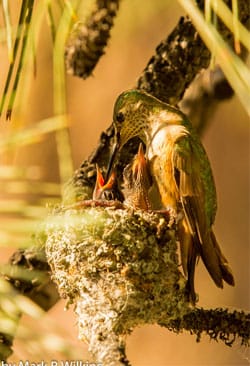Humming along

The Wilkins family in Forest Park witnessed the nesting, hatching, and growth of two baby hummers right in their own backyard this summer.
Article by Kathy Dunker with photos by Mark Wilkins
In the Colorado springtime, many people anxiously await the return of migrating birds. Especially fun to watch are the hummingbirds. Colorado has four species that spend time here.
We have the Broad-tail, Calliope, Black Chinned and the mean little Rufous. The Wilkins family, residents of Forest Park, were in for a special treat this summer, as they got to witness the nesting, hatching, and growth of two baby hummers right in their own backyard.
Most hummingbirds spend the winters in Mexico and Central America and return to spend the summers in the US and Canada. The Rufous actually travels through Colorado in July and August on its way south for the winter.
Hummingbirds are very small, with the largest weighing only 8.4g and the smallest a mere 2.5g. Most hummers flap their wings a whopping 53 times per second. The great amount of expended energy has them eating up to five times their body weight every day.
If you are hoping to attract one of these fun creatures to a feeder, it takes a four-to-one ratio of water to sugar, and feeders should be cleaned once a week. Use only white granulated sugar and food coloring is not necessary when using a bright red feeder. Never use honey or artificial sweeteners because honey can cause fatal infections in hummingbirds.
The male birds arrive before the females and seek out a special territory to better attract a female. The males sometimes arrive before flowers are in bloom so it’s beneficial to have a feeder or two out for these early birds.
It is rumored that you should bring your feeders in on Labor Day to encourage the hummers to get on their way before winter sets in. The fact is that hummingbirds migrate in response to hormonal changes which are triggered by decreasing sunlight. So, nothing will cause them to stay too long! In fact, they need to fatten up for their long journey.
It is recommended that you keep feeders out for at least a week after you have seen the last hummingbird. That allows for any stragglers that are sick or injured to get nourishment if they are leaving later than normal.
Hummingbirds have an amazing memory and will return year after year to a place they have found food plentiful. So keep your feeders full next spring and enjoy the show!